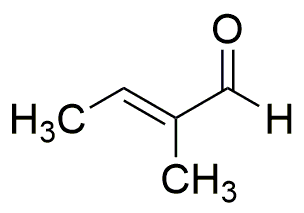trans-2-Methyl-2-butenal is widely utilized in research focused on:
- Flavor and Fragrance Industry: This compound is used as a flavoring agent in food products and as a fragrance component in perfumes, providing a pleasant aroma and taste that enhances consumer products.
- Synthesis of Fine Chemicals: It serves as a key intermediate in the synthesis of various fine chemicals, including pharmaceuticals and agrochemicals, allowing for the efficient production of complex molecules.
- Polymer Production: The compound is employed in the production of specialty polymers, which are used in coatings and adhesives, offering improved durability and performance compared to traditional materials.
- Research in Organic Chemistry: It is a valuable reagent in organic synthesis, facilitating various chemical reactions that are essential for developing new compounds and materials in academic and industrial research.
- Biochemical Applications: Researchers utilize this compound in studies related to metabolic pathways and enzyme interactions, helping to uncover important biological processes and potential therapeutic targets.
Información general
Propiedades
Seguridad y normativas
Aplicaciones
trans-2-Methyl-2-butenal is widely utilized in research focused on:
- Flavor and Fragrance Industry: This compound is used as a flavoring agent in food products and as a fragrance component in perfumes, providing a pleasant aroma and taste that enhances consumer products.
- Synthesis of Fine Chemicals: It serves as a key intermediate in the synthesis of various fine chemicals, including pharmaceuticals and agrochemicals, allowing for the efficient production of complex molecules.
- Polymer Production: The compound is employed in the production of specialty polymers, which are used in coatings and adhesives, offering improved durability and performance compared to traditional materials.
- Research in Organic Chemistry: It is a valuable reagent in organic synthesis, facilitating various chemical reactions that are essential for developing new compounds and materials in academic and industrial research.
- Biochemical Applications: Researchers utilize this compound in studies related to metabolic pathways and enzyme interactions, helping to uncover important biological processes and potential therapeutic targets.
Documentos
Hojas de datos de seguridad (HDS)
La SDS proporciona información de seguridad completa sobre la manipulación, el almacenamiento y la eliminación del producto.
Especificación del producto (PS)
La PS proporciona un desglose completo de las propiedades del producto, incluida la composición química, el estado físico, la pureza y los requisitos de almacenamiento. También detalla los rangos de calidad aceptables y las aplicaciones previstas del producto.
Certificados de análisis (COA)
Busque certificados de análisis (COA) ingresando el número de lote del producto. Los números de lote y de partida se pueden encontrar en la etiqueta de un producto después de las palabras "Lote" o "Lote".
Número de catálogo
Número de lote/lote
Certificados de origen (COO)
Este certificado de origen confirma el país en el que se fabricó el producto y también detalla los materiales y componentes utilizados en él y si se deriva de fuentes naturales, sintéticas u otras fuentes específicas. Este certificado puede ser necesario para cumplir con las normativas aduaneras, comerciales y regulatorias.
Número de catálogo
Número de lote/lote
Hojas de datos de seguridad (HDS)
La SDS proporciona información de seguridad completa sobre la manipulación, el almacenamiento y la eliminación del producto.
DownloadEspecificación del producto (PS)
La PS proporciona un desglose completo de las propiedades del producto, incluida la composición química, el estado físico, la pureza y los requisitos de almacenamiento. También detalla los rangos de calidad aceptables y las aplicaciones previstas del producto.
DownloadCertificados de análisis (COA)
Busque certificados de análisis (COA) ingresando el número de lote del producto. Los números de lote y de partida se pueden encontrar en la etiqueta de un producto después de las palabras "Lote" o "Lote".
Número de catálogo
Número de lote/lote
Certificados de origen (COO)
Este certificado de origen confirma el país en el que se fabricó el producto y también detalla los materiales y componentes utilizados en él y si se deriva de fuentes naturales, sintéticas u otras fuentes específicas. Este certificado puede ser necesario para cumplir con las normativas aduaneras, comerciales y regulatorias.


